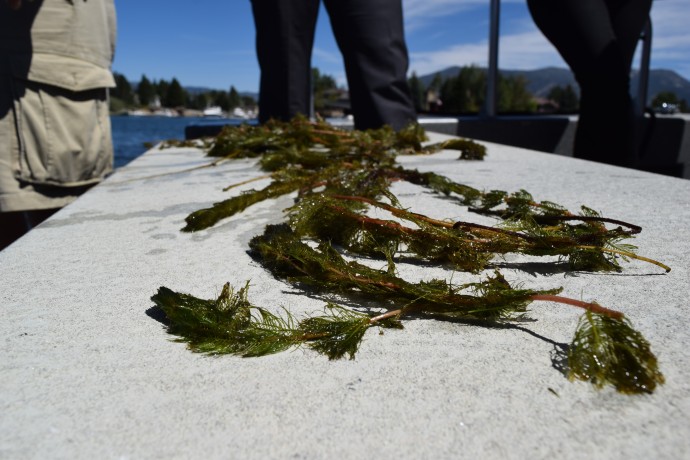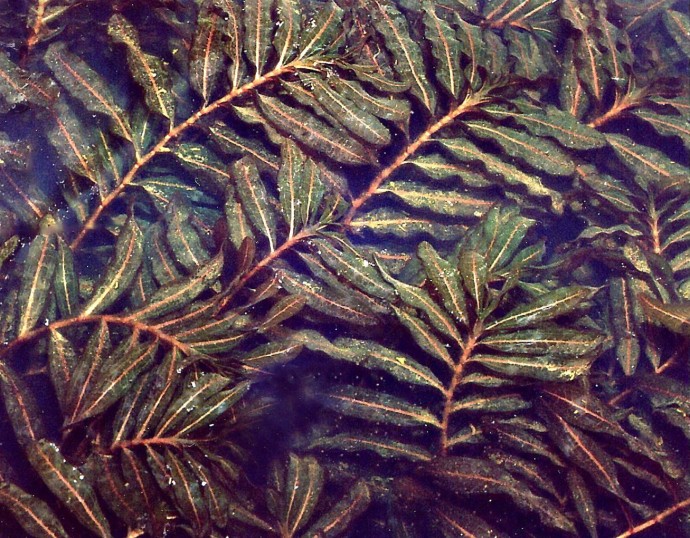By Gwendolyn Temple, WNY Steward
I’ve been noticing lately that hardly any of the boats that have come in from either Big Six Mile Creek or Fort Niagara have aquatic invasive species on them anymore, when weeks ago, they were absolutely covered in both Eurasian watermilfoil and curly leaf pondweed. Curious to know why I haven’t been seeing them recently, I decided to do a bit of research.
Now, typically, Eurasian watermilfoil will flower around, according to the State of Washington Department of Ecology, “mid to late July”, and then die back after the flowers have surfaced.[1]

Figure 1: Eurasian watermilfoil, an aquatic invasive plant species that often chokes out motors during its peak growing season. Credit: Luke Burns
Once they die back, if they haven’t flowered too early, they lie dormant until the next season.[2] As they can survive rather well under ice, it appears as if they can tolerate far lower temperatures than many native aquatic plants can.[3] However, there is no research that I have found that suggests what sort of higher temperatures this plant can sustain itself in.
Currently in the upper Niagara River, where Big Six Mile Creek is located, it is about 80 degrees Fahrenheit. At this point, I cannot fully determine whether it is the warmer temperature this plant is dying back as a result of its growth season. Before the typical season for this particular aquatic invasive started, I saw it coming off boats around early July. So, I would assume that another burst of the plant’s growth should be seen around now. Yet, I have not found any since late July.
Curlyleaf pondweed, on the other hand, ended a bit earlier at both launches. This aquatic invasive’s growing season is in the winter and it grows to become a problem in non-native water bodies around early summer.[4] Then, it dies back until the next major growing season.[5]

Figure 2: Curlyleaf pondweed, as seen growing out of control in a water body. Credit: Christian Fischer
In terms of temperature, when the water drops below 68 degrees Fahrenheit, the plant begins to sprout itself again.[6] As such, it is possible that the reason it has not been seen near Big Six Mile Creek since mid-July is a result of the 80-degree temperature noted in the Upper Niagara River. Of course, I did note that curlyleaf pondweed was being taken off of boats at Fort Niagara a week or two following a lack of it on boats at Big Six Mile Creek. This could be a result of the lower Niagara River being colder than the Upper Niagara due to its proximity to Lake Ontario, which, given the location of my launch, makes perfect sense.
In any case, it seemed rather odd to me to not be picking off invasives from boats in these areas anymore, despite these species being the most pronounced at both launches this season.
Have any of you other stewards been experiencing die-offs of the aquatic invasive species you used to frequently handle? If so, what could be the possible causes for it? I’m very curious to know!
[1] “Non-native Invasive Freshwater Plants: Eurasian Watermilfoil.” State of Washington Department of Ecology. State of Washington Department of Ecology, n.d. Web. 20 Aug. 2016. <http://www.ecy.wa.gov/programs/wq/plants/weeds/aqua004.html>.
[2] “Non-native Invasive Freshwater Plants: Eurasian Watermilfoil.” State of Washington Department of Ecology. State of Washington Department of Ecology, n.d. Web. 20 Aug. 2016. <http://www.ecy.wa.gov/programs/wq/plants/weeds/aqua004.html>.
[3] “Non-native Invasive Freshwater Plants: Eurasian Watermilfoil.” State of Washington Department of Ecology. State of Washington Department of Ecology, n.d. Web. 20 Aug. 2016. <http://www.ecy.wa.gov/programs/wq/plants/weeds/aqua004.html>.
[4] “Curlyleaf Pondweed.” Aquatic Invasive Species (n.d.): n. pag. Apr. 2009. Web. 20 Aug. 2016. <http://www.in.gov/dnr/files/CURLYLEAF_PONDWEED.pdf>.
[5] “Curlyleaf Pondweed.” Aquatic Invasive Species (n.d.): n. pag. Apr. 2009. Web. 20 Aug. 2016. <http://www.in.gov/dnr/files/CURLYLEAF_PONDWEED.pdf>.
[6] Poovey, Angela. “Curlyleaf Pondweed (Potamogeton Crispus L.).” State of Washington Department of Ecology, 2008. Web. <http://depts.washington.edu/oldenlab/wordpress/wp-content/uploads/2013/03/Potamogeton-crispus_Poovey.pdf>.
Figures:
Figure 1: Burns, Luke. 2015 Lake Tahoe Summit. Digital image. Flickr. N.p., 24 Aug. 2015. Web. <https://www.flickr.com/photos/usacehq/21221263823/in/photolist-dWPLDB-p8VkjW-paVntQ-paXukz-3iwope-paXnqc-8xBUm6-deC2jJ-ykfwp2>.
Figure 2: Fischer, Christian. Potamogeton Crispus. Digital image. Wikimedia Commons. N.p., 21 Aug. 2008. Web. <https://commons.wikimedia.org/wiki/File:PotamogetonCrispus.jpg>.
